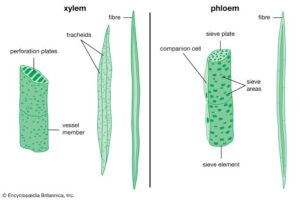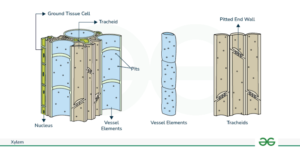Back to: Botany 300 Level
Hello, my brilliant friend! I hope you’re doing great today! Have you ever wondered how water travels from the roots of a tree all the way up to its highest leaves? Unlike humans who have a heart to pump blood, plants don’t have a pump—so how do they move water? The answer lies in a special tissue called xylem!
Xylem is like a plant’s water pipeline, helping to transport water and minerals from the roots to the leaves. Today, we’ll explore the structure, function, and cell types that make xylem such an important part of plant life.
Xylem: Structure, function, and cell types
Structure of Xylem
Xylem is a complex tissue made up of different types of cells that work together to transport water. It has four main components:

Tracheids – Long, thin, tube-like cells with tapered ends.
Vessel elements – Shorter, wider cells arranged in long tubes.
Xylem fibres – Provide strength and support.
Xylem parenchyma – Stores food and helps in the movement of water sideways.
These cells form a continuous network, like a system of pipes, allowing water to move upward from the roots to the leaves.
Function of Xylem
The xylem plays a crucial role in plant survival. Its main functions include:
1. Transporting Water and Minerals
Xylem carries water and dissolved minerals from the roots to different parts of the plant. This process happens through capillary action and transpiration pull—as water evaporates from the leaves, it pulls more water up from the roots like a drinking straw!
2. Providing Mechanical Support
Xylem is made of thick-walled, lignified cells that provide strength to plants. This is why trees can stand tall and withstand strong winds.
3. Storing Nutrients
Xylem parenchyma stores food and minerals, ensuring the plant has a reserve supply when needed.
Types of Xylem Cells
Each xylem cell type has a specific role:
Tracheids
Long, narrow, with tapered ends.
Water passes from one tracheid to another through small pits.
Found in all vascular plants (both flowering and non-flowering plants).
Vessel Elements
Shorter and wider than tracheids
Have perforated end walls, forming a continuous pipe-like structure.
Found mainly in angiosperms (flowering plants).
Transport water more efficiently than tracheids.
Xylem Fibres
Provide mechanical support to the plant.
Have thick, lignified walls, making stems strong.

Xylem Parenchyma
Stores food and minerals.
Helps in the lateral transport of water.
A Simple Story to Understand Xylem
Imagine you are building a water supply system for a city:
Tracheids and vessel elements are like water pipes, carrying water to different places.
Xylem fibres are like concrete walls, giving strength and support to the pipes.
Xylem parenchyma is like a storage tank, keeping extra water and minerals for later use.
Just like a city cannot function without a proper water supply, plants cannot survive without xylem!
Summary
Xylem is responsible for transporting water and minerals from roots to leaves.
It provides mechanical support to plants, allowing them to stand strong.
Xylem is made up of tracheids, vessel elements, xylem fibres, and xylem parenchyma.
Tracheids and vessel elements transport water, while fibres provide strength and parenchyma stores food.
Evaluation
- What is the main function of xylem?
- How does water move up through the xylem?
- What is the difference between tracheids and vessel elements?
- Which xylem cells provide strength and support to plants?
- Why is xylem important for plant survival?
You are doing a fantastic job! Look at you, learning how plants transport water just like engineers design water systems! Keep looking at trees and plants around you, and you’ll start noticing how xylem helps them grow. Keep learning with Afrilearn, and I’ll see you in the next exciting lesson. Stay curious and keep growing!
